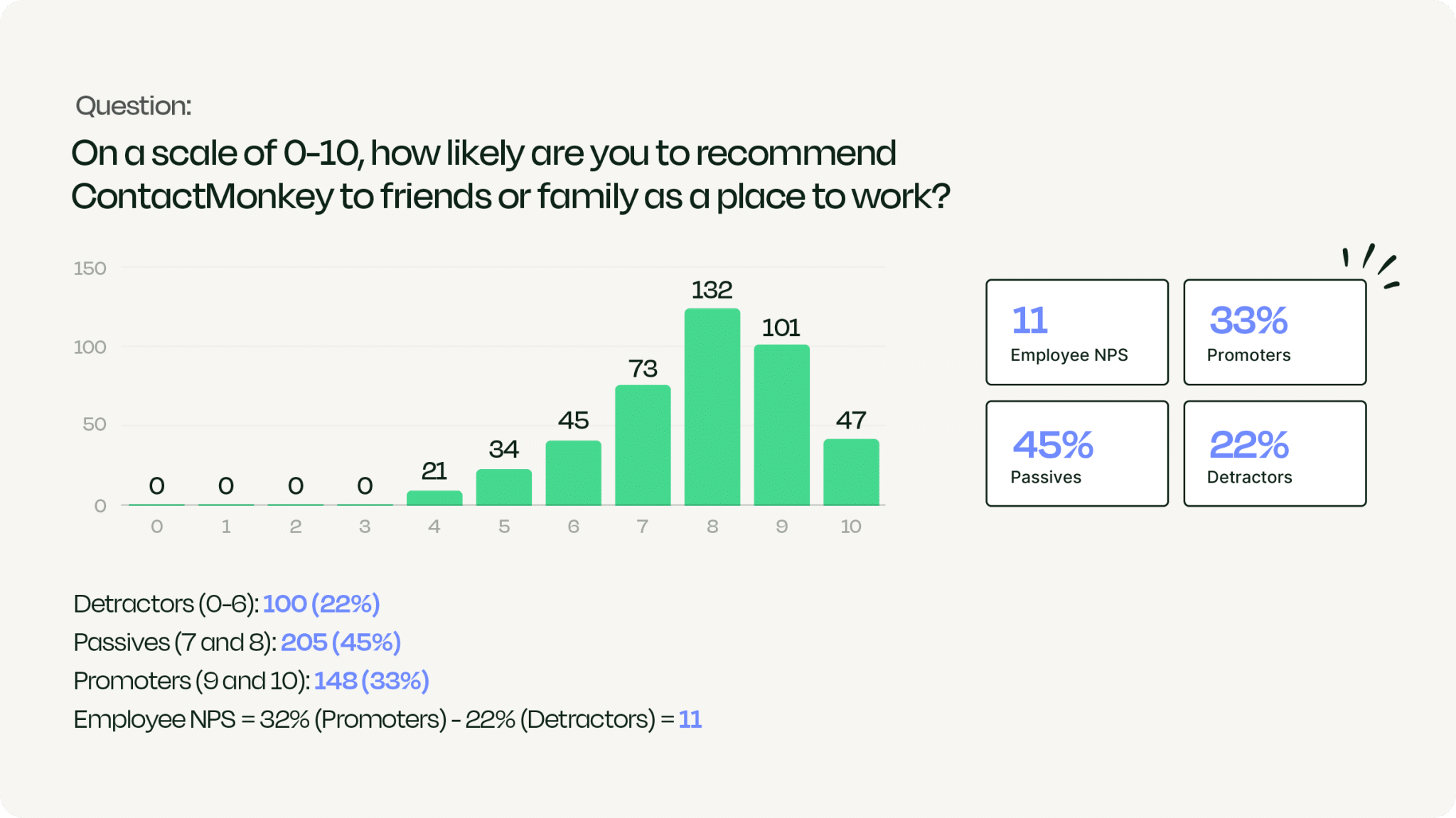Are you looking for ways to build your employer branding with internal communications? Companies spend a lot of time on their external brand. But the internal brand is just as important. By focusing on employees, employers will see benefits all across their business.
Employer branding has been around as long as employees have. Your business already has an employer brand and if you’re not using it to its full potential, it’s time to take back control. When you build up your employer brand, not only will it be easier and cheaper to hire great talent, but you will also keep the talent you’ve been nurturing. Happy employees are more efficient, stay for longer, and spread positive news about your business.
Keep reading to find out how the right internal communications software can help you build a strong employer brand that works for you.
Take a self-guided tour of ContactMonkey
See how our key features can streamline your internal communications.
Take product tour

What Is Employer Branding?
Think of employer branding as a set of strategies designed to promote your company as a great place to work.
The first part of effective employer branding is building a positive employee experience.
That includes establishing a strong company culture, creating opportunities for employee engagement, and gathering continuous employee feedback. It also means fostering an environment where people of all race, gender, and sexual orientation feel included and where diversity is welcomed.
The second part is about communicating the benefits of working at your company to others. That means making good use of social media, creating engaging ‘About’ pages, and using media to give people a glimpse inside your organization.
It’s also important to remember that your employees can be your biggest promoters. If they genuinely love working at your company, they’ll want others to hear about it.
To build a strong employer brand, always gather employee feedback to understand how your company is being perceived. Then, leverage your insights in your employer branding strategy.
Why is employer branding important?
Employer branding can be a game changer for recruitment success. Employer branding gives people outside of your company a glimpse of what it’s like to work there. It determines job seekers’ interest in applying at your company and their expectations of the job once they join.
If you want to attract and retain top talent, effective employer branding is vital. In fact, 75% of job seekers will apply at a company that actively manages its employer brand.
On the other hand, a majority of job seekers would avoid joining a company with a bad reputation and poor employer branding. This means that if you’re not actively building and maintaining your employer brand, you’ll be losing out on top talent.
Not only that, but the person you end up hiring may have a vague understanding of what your company is really like. In the long run, this will lead to unsatisfied employees and poor employee retention.
With effective employer branding, you’ll enhance and expand your talent pool while making sure that new hires have a solid understanding of you as an employer.
3 Key benefits of employer branding
- Attract top talent to your company
- Improve employee loyalty and increase employee retention
- Reduce recruitment costs over time
7 steps to a clear internal communications plan
The internal communicator’s bible to building a winning strategy.
Get the guide

8 Ways to Build a Strong Employer Brand
Now that you know what employer branding is, let’s look at how you can harness it. We break down 8 actionable for implementing effective employer branding at your company.
1. Understand your employer values
When you created your business’ brand originally, chances are you detailed the values of your brand. Brand values are the fundamental principles that guide you through every decision you make. When brands have clear values that they follow, they are cohesive and trustworthy.
When brands have a fancy list of values on their website but never follow them, you get that icky feeling even if you can’t quite put your finger on it. Y’know, like your friend’s new partner who says one thing but does another.
To build a strong employer brand, you’ll need to pin down the values you have as an employer and, crucially, follow throughwith them.
If one of your employer values is to support an open and honest environment, you need to be open and honest with your employees for them to be open and honest with you as well.
By pinning down your employer values, you’ll know exactlywhat you want to get across in all your internal communications. As your employees interact with internal communications, they’ll be able to see and feel your values coming through.
This allows them to gain a greater connection with your brand. Online clothing retailer Zappos is a perfect example of a company that truly lives it’s brand values both externally and internally. Zappos involved its employees in the creation of its 10 core values, which became a way of life at the organization.
2. Create measurable goals for employer branding
Internal communications, from newsletters to polls, can offer unrivaled access to metrics. Measuring these will help you build a strong employer brand because you’ll understand what’s working and what’s not. You can check internal email open rates to see whether that “hilarious” newsletter subject line worked.
To build a solid employer brand that brings new employees in, you’ll need to set measurable goals. These might be to increase employee-to-employee communication or improve employee engagement in events. When you have goals, you can work out how to measure and work towards them.
One way to get started with measuring communications is with ContactMonkey. ContactMonkey enables internal communicators to track employee newsletters from Outlook and Gmail.
With ContactMonkey’s internal communications solution, you can build responsive HTML email templates for your employer branding initiatives and track metrics such as open rates, clicks rates, pulse survey results, and employee net promoter score benchmarks.
20 must-try newsletter ideas for better employee engagement
Give your internal news a fresh spin with these ideas.
Get the guide

3. Ask for employee feedback
When building a strong employer brand, you’ll need to know how your efforts are being seen and experienced by your employees.
Instead of hoping for the best and assuming your efforts are working, strive to get as much feedback as possible.There’sa range of ways in which you can use internal communications to create a feedback system that works for everyone.
Why not have Feedback Fridays?You can also create polls, anonymous or otherwise, about current or proposed changes. Have a space where employees can file anonymous suggestions.
This can be a good way ofhearing about sensitive subjects. Cultivating an open and judgment-free environment through internal communications can solve many issues.
One easy way to do this would be with employee pulse surveys. Pulse surveys can be a quick and easy way to gather honest feedback from employees and help build your employer brand. Corey Kachigan, from Exemplis uses ContactMonkey on a monthly basis to gather employee feedback. This has helped her team gain a data-backed understanding of how employees really feel. Exemplis now averages a 70% open rate on its weekly internal communication.
An effective employee newsletter idea is to feature actions that your business has taken in response to past feedback. This shows that you listen and respect your employees’ ideas and create change where appropriate.
Gather employee feedback from Outlook and Gmail
For example, when Exemplis put in new coffee machines, a survey asked a yes/no question: “Do you like them better or worse than the previous ones?” People could make comments, such as, “I hate that; it slows me down.” The next week Kachigan acknowledged that 70% of the respondents hated the coffee machine—and detailed what they would do about it.

4. Tailor communications to your employer brand
There are some people who enjoy the organizational opportunities afforded them by email inboxes.We should know, we love a slick inbox.Otherpeople get hives just thinking about the word “inbox” though.
While your employees will abide by their job responsibilities, when it comes to internal communications, creating accessible options shows care and respect.
Tailoring your communications means presenting them in a variety of ways. You can create and send beautiful internal email newsletters but also make them available on your company intranet. This means that if an employee only checks their email twice a day to remain productive, they can still read the newsletter online.Engaging employee newsletter names also help entice employees to check out your content.
If you have employees in different time zones, you can tailor your internal communications to make those outside head office feel included. Even a simple “Good afternoon” to those five hours ahead will feel much more personal than a blanket “Good morning” to suit those employees sharing your space.
Or, you could go a step further and personalize internal email subject lines with employee names and other details. A simple way to do this is by using merge fields within your emails. With ContactMonkey, you can personalize all your internal newsletters straight from Outlook or Gmail by adding merge fields.
Start personalizing employee communications from Outlook and Gmail
5. Keep employees updated
If you’re providing important updates, different ways to send these messages and using different channels can ensure that everyone is updated.
Creating a designated space in the staff portal or sticking to the same time every week for need-to-know information can help your employees stay on top of what’s happening internally.
Why not havea section of your internal newsletter that details departures, new starters, and job openings? Imagine if you came into work one morning to find a new colleague sitting next to youwho you knew nothing about. How would an employee feel if they emailed accounts only to have the email bounce back because that staff member has left?
Even if your employees work across different offices and regions, keeping everyone up to date on employee movements shows you care about your team.
Updates can take a variety of forms and you can mix them in with feedback. If your coffee supplier contract is coming to an end, you couldsend out an email survey to see if your employees want the same coffee.
If you need to reach only a segment of your organization, try using custom email lists to target only relevant employees with your emails. This helps improve email engagement by reducing the total number of emails your organization receives.
Using ContactMonkey’s List Management feature, you can easily create your own custom email lists without needing help from IT. These email lists can integrate with your Human Resource Information System (HRIS) like Workday and ADP, as well as Azure Active Directory, so they’ll update automatically as employees join and leave your organization.
20+ most popular templates for internal communicators
Save hours of content creation with these free email templates.
Get the template

6. Bring employees into the fold
Traditionally, there’s been abig divide between business owners and their employees. This “us versus them” mentality might have kept staff in line back in the day but now it creates unnecessary distance.
Businesses can find greater success when employees feel like they’re a valued and integral part of the company. Using effective internal communications can eradicate those barriers andsee employees more engaged with the business as a whole.
Incorporating storytelling with inclusive language can be a brilliant way to make employees feel like they are a part of the business. Internal communications storytelling requires care and attention and when your staff can see that effort has been made, they’ll feel more valued.
When your employees feel like an integral part of the business, they’ll naturally see more value in doing their best work and promoting the company. When you have happy and included employees, they become advocates for your employer brand, spreading the message far and wide.
7. Use your brand voice
What if one internal emailgets sent to everyone in a casual, peppy tone of voice and another in a conservative, superior voice? Your employees will never know how to respond or how they should take the message.
Developing a strong employer brand involves creating the tone of voice you’ll be using throughout your internal communications. Your employer brand voice is the style in which you communicate, the greetings you use, and even the punctuation. Do you stick emojisat the end of your emails? Do you put GIFs in your newsletters?
When you stick to your brand voice, your employees will get to know the heart of your brand faster and feel more connected and familiar with it. They’ll come to know and trust what you say because you’ve built a personality they relate to.
8. Highlight and recognize employees
Part of your employer brand is based on how you treat your employees’ achievements. Around 79% of employees worldwide cite lack of appreciation as a top reason for leaving a job.
Taking the time to acknowledge, highlight, and appreciate the time and effort your employees put in could be the best way to retain staff and keep them happy.
Internal communications, such as newsletters and bulletins, are a great way of recognizing staff achievements. You can highlight achievements inside work as well as outside, such as sporting or educational achievements. This shows that you respect and encourage their work/life balance and appreciate them as an employee.
When recognizing employees in internal communications, it’s a good idea to balance your focus. Recognizing the work of support staff is just as important as showcasing high-performing sales staff.
Build Your Employer Brand with Outstanding Internal Communications
Building an employer brand that stands out is the best way to attract new talent and retain your existing employees. Hiring costs are large enough as it is without having to spend more overcoming a poor internal reputation.Not to mention the cost of waving goodbye to fantastic but under-appreciated workers.
Internal communications are essential for building a strong employer brand as they connect you with every single employee. By fostering an open, communicative environment, you canget honest feedback and make positive changes your employees actively want.
By using newsletters to highlight achievements,employees feel recognized, valued, and like integral parts of the business. They’ll become advocates forthe company and help boost your employer reputation externally too.
Need help creating content for your internal newsletters? Try using ContactMonkey’s OpenAI ChatGPT integration to quickly and easily generate content for your internal communications.
TL;DR: 8 Tips for Building an Employer Branding with Internal Communications
- Understand your brand values and how they shape your employee experience.
- Create measurable goals to help you understand what’s working and what’s not.
- Turn communication into a two-way channel and ask employees for feedback.
- Tailor and personalize your communications by channel, message and demographics.
- Proactively keep employees updated when it comes to company news, changes or during a crisis
- Make your employees the decision-makers. Use inclusive language and storytelling to make your employees feel like business owners.
- Stay true to your brand voice in all internal communications from internal newsletters, to intranet news or Yammer updates.
- Embrace employee appreciation.
There’s nothing worse than an internal newsletter that’s so dull it never gets opened. To create trackable, visually stunning newsletters that get read, book your free demo today.By providing your employees with newsletters theywant to open, you’ll be well on your way to creating a strong employer brand.



